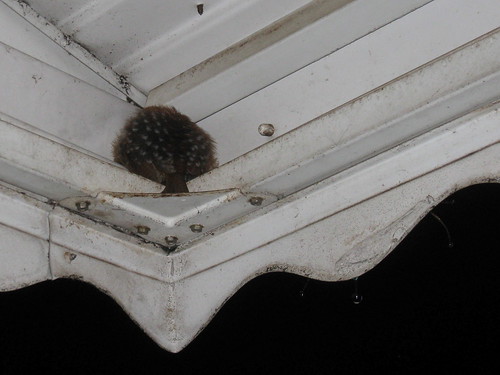Because of the dire predictions of storms crawling across the bottom of the TV screen all day, I had my flashlight ready. With the added light, I recognized the color. It was not a rodent or ball of goo, it was a Carolina Wren!
In spite of my closeness, the wren didn't budge. She even tolerated the flash of my camera. Was she sound asleep, or just riding the storm out? We had straight-line winds that night—March 4—and nearby Illinois had numerous tornadoes.
Tolerant as she was, it's unlikely that the bird was unaware of my presence. Mike O’Connor, in his 2007 book Why Don't Woodpeckers Get Headaches? And Other Answers to Bird Questions You Know You Want to Ask (p. 188), tells us that birds sleep lightly, ready to fly if danger threatens. He explains that a bird often sleeps by turning its head towards its back and settling its beak onto its shoulder. I can't say if my little feathered friend is using this method in the photo above, but I can at least see that her feathers are fluffed to help trap warmth. I'm sure she appreciated the awning that night, since in addition to the high winds and rain, the temperature was in the high 30s F. By the way, O’Connor is a lively and entertaining writer. I really get a kick out of this book!
Birds need to take advantage of every opportunity for shelter left to them in the suburbs. Tom over at Mon@rch's Nature Blog, wrote about an American Goldfinch that he spotted as it turned in for the night in the gap between his foundation and a snow bank. The "Father of English Literature" also wrote about napping birds in the "Prologue":
And smale foweles maken melodye,
That slepen al the nyght with open eye
Back in the day, Geoffrey Chaucer and his pilgrim friends would have pronounced that last word as "ee," so it really did rhyme with "melodye." Old Geoff was more accurate than we thought. Former St. Louisan and Big Day birding teammate of mine, Niels Rattenborg, demonstratted in his research that birds can put one half of the brain to bed, while leaving the other half—and the eye that it controls—alert to danger. Using this unihemispheric form of sleep even allows some birds to fly while they sleep!

Very cool. Or chilly? :)
ReplyDeleteYes to both!
ReplyDelete:) Thanks for linking and loved reading about this bird.
ReplyDelete